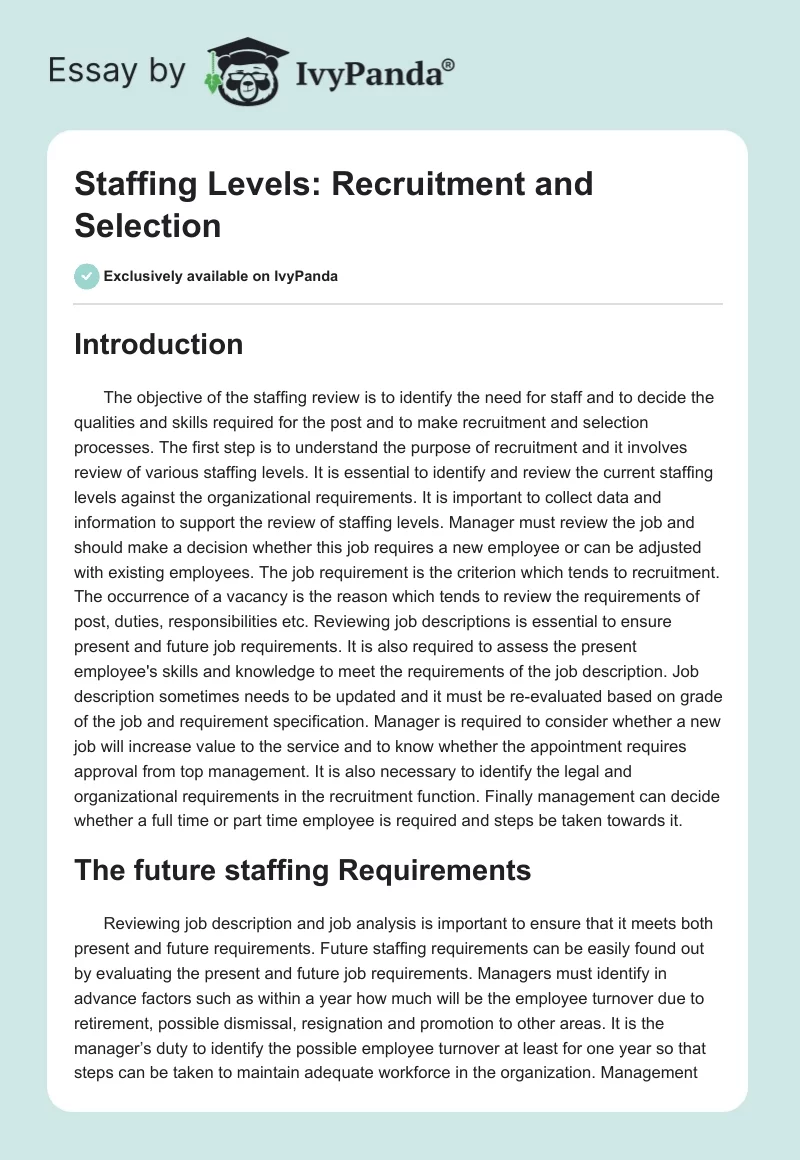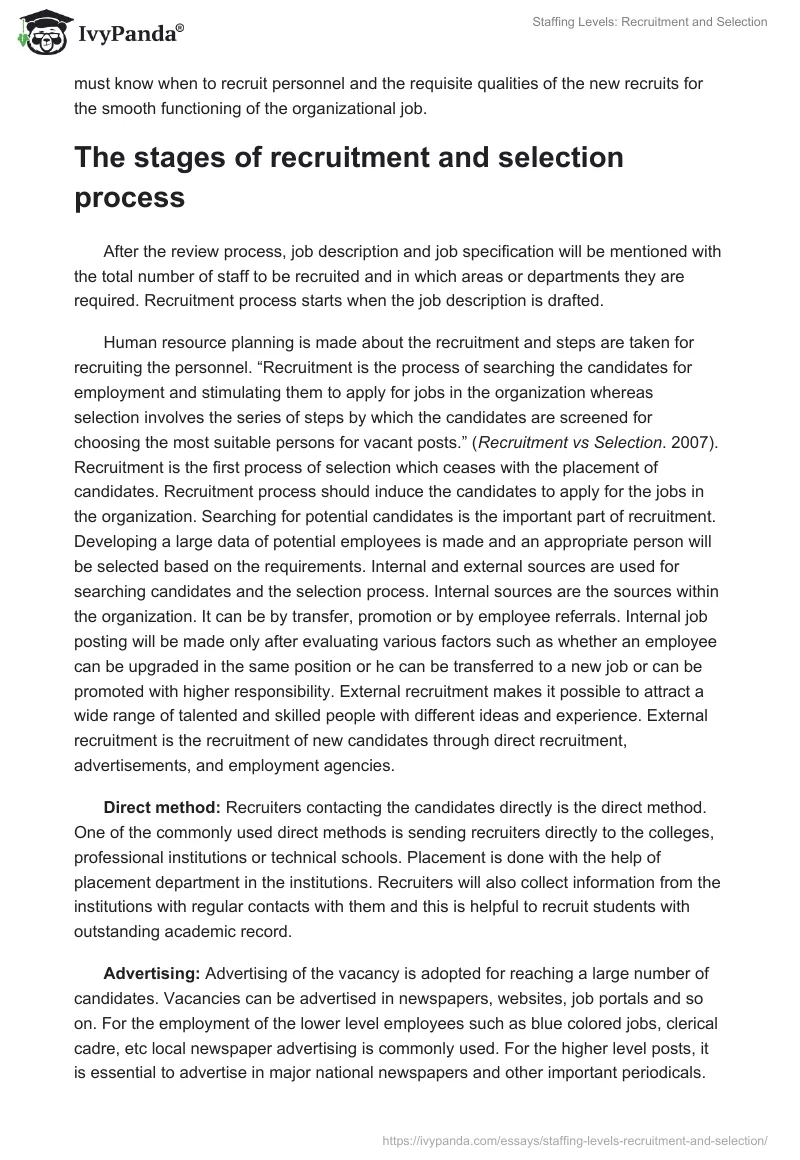Introduction
The objective of the staffing review is to identify the need for staff and to decide the qualities and skills required for the post and to make recruitment and selection processes. The first step is to understand the purpose of recruitment and it involves review of various staffing levels. It is essential to identify and review the current staffing levels against the organizational requirements. It is important to collect data and information to support the review of staffing levels. Manager must review the job and should make a decision whether this job requires a new employee or can be adjusted with existing employees. The job requirement is the criterion which tends to recruitment. The occurrence of a vacancy is the reason which tends to review the requirements of post, duties, responsibilities etc. Reviewing job descriptions is essential to ensure present and future job requirements. It is also required to assess the present employee’s skills and knowledge to meet the requirements of the job description. Job description sometimes needs to be updated and it must be re-evaluated based on grade of the job and requirement specification. Manager is required to consider whether a new job will increase value to the service and to know whether the appointment requires approval from top management. It is also necessary to identify the legal and organizational requirements in the recruitment function. Finally management can decide whether a full time or part time employee is required and steps be taken towards it.
The future staffing Requirements
Reviewing job description and job analysis is important to ensure that it meets both present and future requirements. Future staffing requirements can be easily found out by evaluating the present and future job requirements. Managers must identify in advance factors such as within a year how much will be the employee turnover due to retirement, possible dismissal, resignation and promotion to other areas. It is the manager’s duty to identify the possible employee turnover at least for one year so that steps can be taken to maintain adequate workforce in the organization. Management must know when to recruit personnel and the requisite qualities of the new recruits for the smooth functioning of the organizational job.
The stages of recruitment and selection process
After the review process, job description and job specification will be mentioned with the total number of staff to be recruited and in which areas or departments they are required. Recruitment process starts when the job description is drafted.
Human resource planning is made about the recruitment and steps are taken for recruiting the personnel. “Recruitment is the process of searching the candidates for employment and stimulating them to apply for jobs in the organization whereas selection involves the series of steps by which the candidates are screened for choosing the most suitable persons for vacant posts.” (Recruitment vs Selection. 2007). Recruitment is the first process of selection which ceases with the placement of candidates. Recruitment process should induce the candidates to apply for the jobs in the organization. Searching for potential candidates is the important part of recruitment. Developing a large data of potential employees is made and an appropriate person will be selected based on the requirements. Internal and external sources are used for searching candidates and the selection process. Internal sources are the sources within the organization. It can be by transfer, promotion or by employee referrals. Internal job posting will be made only after evaluating various factors such as whether an employee can be upgraded in the same position or he can be transferred to a new job or can be promoted with higher responsibility. External recruitment makes it possible to attract a wide range of talented and skilled people with different ideas and experience. External recruitment is the recruitment of new candidates through direct recruitment, advertisements, and employment agencies.
Direct method: Recruiters contacting the candidates directly is the direct method. One of the commonly used direct methods is sending recruiters directly to the colleges, professional institutions or technical schools. Placement is done with the help of placement department in the institutions. Recruiters will also collect information from the institutions with regular contacts with them and this is helpful to recruit students with outstanding academic record.
Advertising: Advertising of the vacancy is adopted for reaching a large number of candidates. Vacancies can be advertised in newspapers, websites, job portals and so on. For the employment of the lower level employees such as blue colored jobs, clerical cadre, etc local newspaper advertising is commonly used. For the higher level posts, it is essential to advertise in major national newspapers and other important periodicals.
Employment agencies: This is the recruitment with the help of employment agencies and other placement associations. In most cases consultants will arrange for the interview of the candidates with the organization. Usually employment agencies will collect certain amount from the candidates for their service. Some times, organization will directly contact the placement consultants for data base and if selection is made with their data base, organization is required to pay for the services of the consultants.
Selection
After receiving the candidates’ applications, selection process starts. Selection aims at eliminating unsuitable candidates and recruiting the most suitable candidates. “Selection is the process used to identify and hire individuals or groups of individuals to fill vacancies within an organization. Often based on an initial job analysis, the ultimate goal of personnel selection is to ensure an adequate return on investment.” (Difference Between Recruitment and Selection: Selection. 2006).
There is no shortcut for evaluating a candidate and well defined recruitment policy and procedures are essential for recruiting right candidate. First important step in the selection process is the establishing of selection policies and identifying and choosing the selection criteria. Second step is the collection of information about the candidates through different methods and sources. Rejection of unsuitable candidates is done by screening of applications, employment tests, interview, background investigation, medical examinations. Third step is the evaluation of information and the assessment of applicants. Last stage is the acceptance or rejection of the candidate. Finally selection will be communicated to the candidate and steps will be taken for appointment. Selection will be purely based on the requirements of the organization otherwise all efforts and money spent will get wasted.
Legal requirements for recruiting and employing staff and ensuring equality of opportunity
There are several legal requirements for employing and recruiting staff. Employment Relations Act and Human Rights Act make it unlawful to discriminate during recruitment and employment. “The U.S. EEOC enforces Title VII of the Civil Rights Act of 1964, the Age Discrimination in Employment Act (ADEA) of 1967, the Equal Pay Act of 1963, Title I and Title V of the Americans with Disabilities Act of 1990, Section 501 and 505 of the Rehabilitation Act of 1973, and the Civil Rights Act of 1991.” (Equal Employment Opportunity Commission. 2004).
Age Discrimination: It is illegal to discriminate any one because of age according to the new rules passed on 1st October 2006. Employers are required to ensure that policies are fair to all young and old people.
- Disability discrimination Act: This Act protects employees from any type of discrimination. This Act also ensures making appropriate changes to support physically disabled employees. “The Americans with Disabilities Act (ADA) prohibits discrimination against people with disabilities in employment, public services and transportation and places of public accommodation. In the employment context, the ADA essentially prohibits discrimination against qualified individuals with a disability who can perform the essential functions of the position held or desired with or without reasonable accommodation, which does not impose an undue hardship on the employer.” (Equal Protection. 2004).
- Contracts of Employment: Contracts of employment is the legal requirement. “Contract of employment is a legal agreement between an employer and an employee. It comes into force when an employee agrees to work for an employer in return for pay. An employer is legally required to put some of the main details of an employee’s work in writing – including hours, pay and leave.” (Employing Staff: Contracts of Employment. 2007).
For ensuring equality of opportunity it is essential to provide good internal education to the employers. Research must be conducted to understand human resource issues in the organization. Corporate management reviews should be designed to identify and remove barriers to the minorities and disabled people in the workplace. Providing awareness regarding benefits and privileges of the employees is essential for enforcement of law.
Bibliography
Difference Between Recruitment and Selection: Selection. (2006). [online]. 2009. Web.
Equal Employment Opportunity Commission. (2004). [online]. Wash Law: Legal Research on the Web. 2009.
Equal Protection. (2004). [online]. United Nations: Enable. 2009. Web.
Employing Staff: Contracts of Employment. (2007). Web.
Recruitment vs Selection. (2007). [online]. Recruitment Naukrihub.com. 2009. Web.


